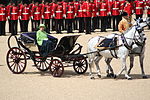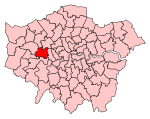Murder of Jean Bradley

The murder of Jean Bradley was the notorious and apparently motiveless stabbing of a woman in Acton, London on 25 March 1993. The case made headline news at the time due to a dramatic chase of the killer by a witness and since it was the second unexplained stabbing of a woman in west London in the early 1990s following the murder of Penny Bell in 1991. Despite the high profile of the killing and an appeal on the prime-time programme Crimewatch in the same year, the murder remains unsolved. Several people witnessed the murder and a passing carpenter came face-to-face with the killer during a confrontation before pursuing him for over a mile as he ran from the scene, with the attacker being last seen walking up Buckland Walk walking towards Acton High Street. The murderer, described as a strange individual, was noted for wearing a peculiar sou'wester hat and had been carrying the knife he used to repeatedly stab Bradley inside a black bag. With the killer having been seen by several witnesses, including the carpenter who confronted the man, detectives were confident of quickly solving the case, with the lead detective on the case commenting: "when we find the man, we will have no difficulty with identification". A local man with severe mental health problems was charged with the murder later in the year after key witnesses, including the man who had chased him, picked him out in identification parades. However, a magistrate unexpectedly dismissed the case against him at the early stages due to the fact that other witnesses had not identified him. No other suspects have ever been arrested or charged since. In 2008, the case returned to the news when there was speculation linking the murder to Robert Napper, who had just been convicted of the infamous murder of Rachel Nickell. However, no links were found and Napper does not match the descriptions given by the witnesses who saw and confronted the killer. The murder, an apparently random attack by a stranger, continues to receive publicity.
Excerpt from the Wikipedia article Murder of Jean Bradley (License: CC BY-SA 3.0, Authors, Images).Murder of Jean Bradley
Carbery Avenue, London Acton (London Borough of Ealing)
Geographical coordinates (GPS) Address Nearby Places Show on map
Geographical coordinates (GPS)
| Latitude | Longitude |
|---|---|
| N 51.503052963001 ° | E -0.28523709551253 ° |
Address
Carbery Avenue
Carbery Avenue
W3 9AB London, Acton (London Borough of Ealing)
England, United Kingdom
Open on Google Maps








